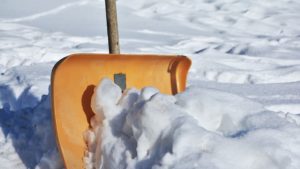 While I don’t often see snow where I live, I know that shoveling heavy snow can be time-consuming and exhausting for those in colder areas. Snow that accumulates on driveways and walkways can also pose a safety hazard. If you live somewhere that gets a lot of snow in the winter, keep these winter snow removal tips in mind to help you stay safe and lighten the load.
While I don’t often see snow where I live, I know that shoveling heavy snow can be time-consuming and exhausting for those in colder areas. Snow that accumulates on driveways and walkways can also pose a safety hazard. If you live somewhere that gets a lot of snow in the winter, keep these winter snow removal tips in mind to help you stay safe and lighten the load.
Place Stakes Along Paths
When snow starts to accumulate, it can be hard to determine where your lawn ends and the path or roadway begins. Staking your lawn is an easy and inexpensive way to identify boundaries. Lawn markers should be tall enough to remain exposed above the snow, durable enough to withstand the elements, and brightly colored to ensure high visibility. In addition to staking pathways and driveways, you may also choose to identify other areas of your property that you need to clear or avoid, such as fire hydrants, retaining walls, garden beds, patio edges, and boulders or stumps.
Cover Your Vehicle With a Tarp
If you keep your vehicle outside, before a big snowfall or major winter storm, cover it with a waterproof tarp. The tarp should be large enough to touch the ground on all sides and should have anchors to keep it in place. Once the snow stops falling, simply pull the tarp off and your vehicle should be free of snow.
Invest in a Good Shovel
A good shovel can make all the difference when shoveling snow. Cheap, flimsy shovels can crack and sag under heavy snow. A high-quality shovel is durable enough to withstand heavy loads and can be used for everything from snow removal to scraping ice buildup. Keep in mind that shovels with longer handles are better suited for pushing large amounts of snow, while shorter handles are better equipped for light snow removal. A shovel with contoured handles is a great choice for people with chronic leg or back problems.
Blow Away Light Dustings of Snow
Snow removal can be hard on the back. Relieve the stain by using a leaf blower to blow away light dustings of snow from your driveway, walkways, and steps. Tackle heavy snow accumulations with a snow blower instead of a shovel.
Melt Snow and Ice Quickly
When the weather gets really cold, snow can quickly turn into ice. Ice melt and other store-purchased de-icers can be quite effective at melting snow and ice. For an effective alternative to traditional salt, combine a half-gallon of water with one tablespoon of rubbing alcohol and one tablespoon of dish soap. Pour the mixture onto driveways, paths, and steps to help melt snow and ice quickly.
Use a Roof Rake
Snow accumulation on your roof can not only be a major safety hazard, but it can also cause extensive damage to your roof. If your attic is not properly ventilated, ice dams can form at the edge of the roof, leaving water to pool behind them. Over time, the water can leak into your home, causing damage to walls, ceilings, and other areas. A roof rake is equipped with a long handle to help safely scrape snow off of the roof and onto the ground.
